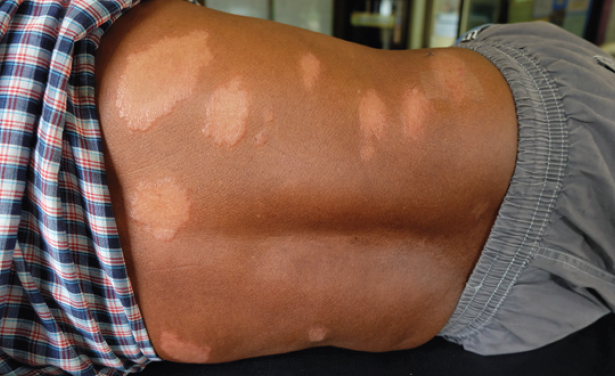
A crewmember disembarked with suspected dermatitis and was diagnosed with Hansen's disease one month later. The crew were notified of this diagnosis and treated as contacts. Recommendations for post exposure treatment and monitoring were advised.
Hansen's disease, commonly known as 'Leprosy', is an infection caused by Mycobacterium Leprae or M. lepromatosis. It is characterised by one or more of the following symptoms: hypopigmented or erythematous skin lesion(s) with loss of sensation; involvement of the peripheral nerves, as demonstrated by loss of sensation; paraesthesia (tingling of hands and feet); and weakness of the muscles of the hands, feet or face.
The World Health Organization (WHO) suggests that the incubation period of the disease, on average, is five years. Symptoms may occur within one year but can also take as long as twenty years or even more to appear. There were 127,558 new leprosy cases detected globally in 2020, according to official figures from the WHO.
Subsequent symptoms include painless ulcers, skin lesions in the form of hypopigmented macules (flat, pale areas of skin) and eye damage (commonly lesions) caused by dryness, decreased blinking and trauma. The term leprosy has been so heavily stigmatised that it has become synonymous with abandonment, social isolation, and condemnation to a lifetime at the margins of society.
Due to the stigma surrounding leprosy, it is important to ensure that contact are made aware that early detection, accurate diagnosis and prompt treatment are essential. Hansen's disease, if left untreated, can lead to permanent nerve damage and disfiguration. Currently, leprosy is a curable condition and is treatable with a combination antibiotics. The stigma surrounding leprosy does not match the reality that this is a curable and fully treatable condition when diagnosed early.
Diagnosis of and treatment recommendations for leprosy includes:
- Early diagnosis
- Treatment of infected individuals and prolonged contacts
- Examinations for a period of five years after last contact with an infected individual
Accurate diagnosis requires skin smears or a biopsy. These will show the presence of acid-fast bacilli, with the Ziehl Neelsen stain or the Fite stain. If bacteria are absent, diagnosis of paucibacillary leprosy may be concluded. Other, less commonly used tests include blood examinations, nasal smears and nerve biopsies.
Hansen's disease infection cannot be transmitted through touch as bacteria are not able to cross the skin. It is thought to be spread through infected droplets (coughing or sneezing), or possibly through insect transmission. The only known reservoir of transmission is humans. However, transmission of infection occurs through prolonged contact (defined as months or years) with someone who has untreated leprosy, and not through casual contact.
It cannot be contracted through:
- Shaking hands or hugging
- Sitting near someone
- Sitting together with someone for a meal
Therefore prolonged contact crew could be considered at risk of exposure and should be notified and treated as contacts. Exposed crew members should be advised to remain vigilant of signs of the disease after exposure has occurred.
Recommendations for the exposed contact crew:
- All crewmembers who were in contact during an affected crewmember's time on board should be submitted to annual testing by a specialised dermatologist who will be able to perform the necessary diagnostic testing.
- All crewmembers who were in contact should take Rifamycin 600mg pos ONCE as an early-stage treatment. This is to be taken as one SINGLE DOSE.
NOTE: Rifamycin may alter the colour of urine. - All crew are advised to remain vigilant to signs and symptoms of the disease for up to twenty years post exposure.
- Shipowners should ensure that exposed crew are aware that Hansen's is a curable condition and is treatable with a combination of antibiotics, when diagnosed early.
- Mental health support should be offered to all crew.
Leprosy is one of the most stigmatised diseases in the world. People affected by the condition are often marginalised in society. A leprosy diagnosis can lead to divorce, loss of a job or business, or homelessness. Unsurprisingly, people often experience poor mental health as a result of a diagnosis. Improved support and education concerning this condition are essential to improving early detection and treatment. Special attention needs to be given when considering crew diagnosis as the implications for potential contacts are altered by the environment aboard a ship.
Written by Venetia Lawrence, Marine Consultant Specialist Nurse, Oceans Marine Ltd.
References
1. Leprosy - Symptoms, diagnosis and treatment. Maria Ochoa et al. Nov 2022. Leprosy - Symptoms, diagnosis and treatment | BMJ Best Practice
2. Leprosy key facts. World Health Organization. Jan 2022. Leprosy (who.int)
3. Abandoning the stigma of leprosy. Kumar A et al. Feb 2019. The Lancet vol 393, issue 10170 p378. Abandoning the stigma of leprosy - The Lancet
4. Fighting stigma and advocation for change. The Leprosy Mission England and Wales. Jan 2023. Fighting stigma and advocating for change (leprosymission.org.uk)
For more information about our Crew Health articles, please contact Sophia Bullard, Crew Health Programme Director, who would be pleased to assist you.




